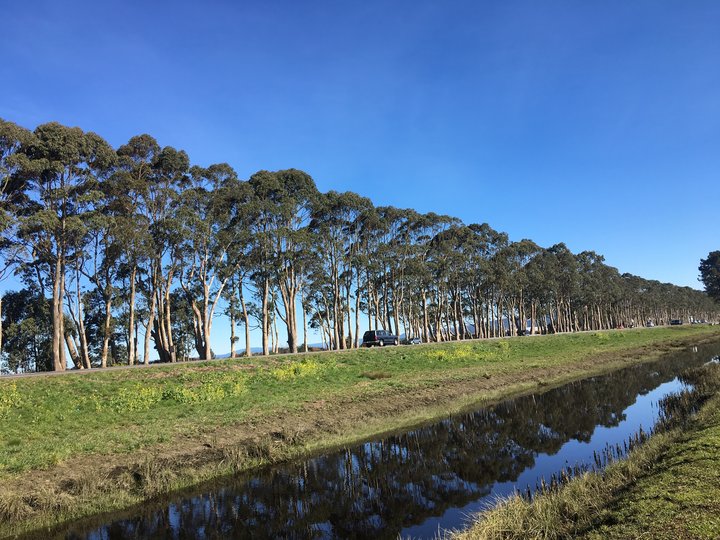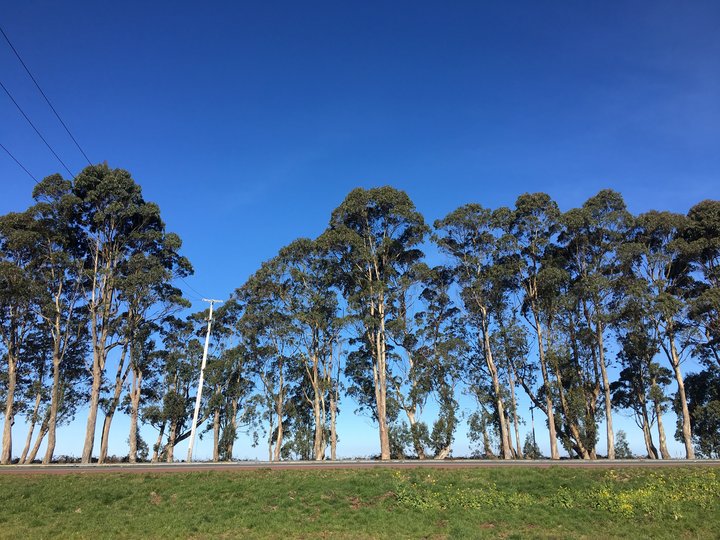
Will these trees go too? The southern section of eucalyptus lining highway 101
Though many locals are fond of the familiar blue gum eucalyptus trees that line Highway 101, the county has spoken: In order for the highly anticipated Humboldt Bay Trail to be completed, the northern section of those trees have got to go.
Now it looks like the southern portion of the trees are facing the possibility of being cut down as well.
Caltrans public information officer Myles Cochrane has confirmed to the Outpost that Caltrans is “looking at hiring a third-party arborist to look at the health and safety of the trees.”
Cochrane said the decision stemmed from the the county’s assessment of the northern section of the trees. As a part of the Humboldt Bay Trail’s CEQA evaluation, county staff recommended removal of the trees, citing safety as the primary concern. Because eucalyptus trees have a documented history of releasing their branches without warning, there was worry that this could be potentially hazardous for pedestrians and bicyclists on the the trail.
Later these concerns were affirmed, when the county hired consulting arborist Torrey Young to provide his professional opinion. In his presentation to the Humboldt County Board of Supervisors, Young said the northern trees should come down because they were showing signs of structural weakness and decay, having large limbs with “weak attachments,” giving them a high potential for causing “significant property damage, injury or death.”
This assessment seemed more than enough to convince the Board that those trees need to come down before construction could begin on the Bay Trail, despite the outcry of some citizens who wanted the trees to stay.
It was also enough for some to prompt the question: if the condition of the northern trees is so bad, might the southern trees also present a potential safety hazard?
Young was only hired to assess the northern portion of the trees and made a point of ignoring the larger group of trees to the south, which are controlled by Caltrans and not the county. The Bay Trail would also only run alongside the northern section of the trees, with the southern portion posing no threat to trail users.
However, the trees run right next to the highway and could pose potential traffic hazards. This seemed enough of a reason for Caltrans to look into this issue further.
Mary Ann McCulloch, president of the Eureka Heritage Society, is against the removal of the northern section of the trees and was not surprised to learn that Caltrans was planning to hire someone to look at the southern section.

image from the Humboldt Bay Trail, showing the southern and northern portions of the trees
“Now that there has been a study done, Caltrans might be able to use that to get rid of them,” McCulloch told the Outpost. “Which is something they’ve wanted to do for years.”
Caltrans did consider removing the trees in 2008 as a part of the 101 Corridor Improvement Project, due to maintenance issues. But after members of the public spoke against removal, Caltrans decided the trees should stay.
Those against removal have cited the beauty, historical significance and service as wind protection for the highway as reasons to keep the trees, which were planted as a wind block nearly 100 years ago by Henry Devoy. (The current trees are second-growth, and have been there since the 1930s.)
Another consideration, McCulloch pointed out, is that eucalyptus trees grow back when you cut them. McCulloch charges this will create even more maintenance costs and hassles for Caltrans, because they will have to continue cutting the trees down.
Of course there is the possibility that the arborist will not recommend removal of southern portion of the trees. For one thing, people are not expected to walk and bike under the trees regularly. Also, the trees are in a slightly different location with different soil conditions. Cochrane also told the Outpost that Caltrans will be hiring a different consulting arborist than the county, to ensure they are getting a unique perspective.
With the Humboldt Bay Trail inching closer to construction and the northern section of the trees days being numbered, McCulloch certainly holds out hope that the southern eucalyptus will stay.
“For me it’s about finding that balance of maintaining something that’s been a visual part of that road for such a long time,” she said.

CLICK TO MANAGE